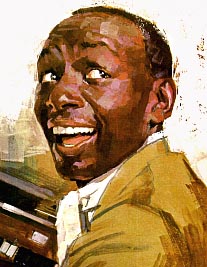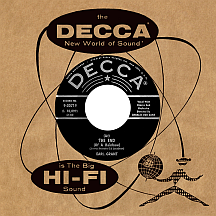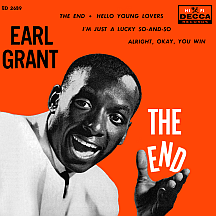EARL GRANT
(At) The End (Of a Rainbow)
There are some who would cast doubt on Earl Grant's place in history as a meaningful artist. His early recordings come off as derivative but are very much in line with the standards of music production in the 1950s, when it was common practice to record cover versions of popular songs. He rose above convention through a combination of two things: his musicianship rooted in jazz and honed through extensive study and practice, and a singing voice of rare quality, if just a bit too similar to an established "King" of the music industry.
One of 12 children, Earl became fascinated with the sound of the organ in the Baptist church where his father served as a minister. He studied piano during his adolescent years and, after leaving his native Oklahoma City, attended colleges in Chicago and Kansas City to further his music education. He performed in El Paso, Texas nightclubs while stationed in the Army at Fort Bliss. Heading for Los Angeles after his discharge in 1955 he enrolled at the University of Southern California and supported himself working the jazz club scene as a singer and pianist. After a year or so, a contract offer was made by Decca Records, a label he stayed with throughout his entire career. He debuted with a near-soundalike pop vocal cover of Jesse Belvin's R&B hit "Goodnight My Love" (titled "Goodnight My Love, Pleasant Dreams," it was overshadowed by The McGuire Sisters' hit version). His third single, the Otis Blackwell-Eddie Cooley classic "Fever," is a jazzier variation on Little Willie John's benchmark hit, featuring both piano and organ backing his vocal performance, but the record faltered as had previous releases. He made a vocal recording of "Honky Tonk," but the instrumental original by Bill Doggett was so dominant as to stave off all comers.
Earl finally scored a hit in late 1958 with the heartfelt ballad "(At) The End (Of a Rainbow)," written by Sid Jacobson (who composed hits for several other artists including top tens by Frankie Avalon and The Ivy Three) and Jimmy Krondes, its unusual double-parentheses title shortened to, simply, "The End" on later pressings of the single as well as an EP and accompanying album (with liner notes proclaiming "He's The End...and that's only the beginning!"). The song was the kind that had people wiping their tears ('...our love has a treasure our hearts can always spend...and it has a story without any end...') though there was some confusion due to Grant's striking vocal similarity to Nat "King" Cole. But this song was not a cover, it was Earl's alone, and listeners eventually became familiar with his sound. Having a nice chart run the final four months of 1958, it was a top ten hit in October and November.
He took a similar vocal approach with the early-'59 follow-up "Evening Rain" (written by Leon Pober, who made a bigger splash nearly eight years later with "Tiny Bubbles" by Don Ho) and recorded an instrumental version of the song for the flip side (labeled as "A Piano Solo by The Versatile Earl Grant," coincidentally the title of a previous album); that alternate take, a faster-tempo version, reveals a fluent player on par with the great classical pianists. His popularity opened the door for a sweet assignment singing the title theme for one of the year's high-profile films, director Douglas Sirk's Imitation of Life starring Lana Turner. Earl channeled his inner calypso with "House of Bamboo" ('...it's-a made of sticks, sticks and bricks, but you can get your kicks!'), a creation of Bill Crompton (he wrote "Why" with Tony Sheridan, recorded in '61 by Sheridan and The Beatles) and Norman Murrells. The infectious dance tune with a cha-cha rhythm spent a few weeks on the national charts in the spring of 1960 and is considered by some his best work.

While it was a vocal hit that made him famous, Earl Grant is perhaps better remembered as an instrumentalist. His album Ebb Tide and Other Instrumental Favorites was a top ten seller in 1961, certified gold by the RIAA; Beyond the Reef came on strong the following year as he leaned towards dreamy island 'scapes and joyous, churchlike arrangements popular with a large percentage of adult record buyers. A track from the latter LP, Grant's original, bouncy organ piece "Swingin' Gently" (with a lil' bit of piano) became his second biggest hit, reaching the top 50 of the singles charts in June 1962. An intense version of Ray Charles' instrumental "Sweet Sixteen Bars" overlaid Earl's piano and organ to magnificent effect and had a respectable chart run that fall.
There were guest appearances on a number of TV variety shows in the late '50s and '60s, most frequently The Tonight Show starring Jack Paar and The Ed Sullivan Show, and Earl had a small role in the 1962 drama film Tender is the Night. Acknowledging the public's perception, or confusion, regarding his vocal similarity to Nat "King" Cole, he recorded the inevitable tribute album, Earl Grant Sings and Plays Songs Made Famous by Nat Cole, in 1965, several months after the singer's death at age 45. Near year's end he returned to the charts with "Stand By Me," an instrumental piano-and-organ remake of Ben E. King's 1961 smash. For the '66 holiday season he applied his signature organ sound and Cole-esque vocals to the Christmas classic "Silver Bells," a strong seller for several years afterward.
Earl Grant's end came abruptly. He and his second cousin, Roosevelt Woods, Jr., both died while on a road trip to El Paso in June 1970 when the Rolls Royce Earl was driving veered off Interstate 10 near Lordsburg, New Mexico. Not yet 40, it's disheartening to try to imagine the sort of musical brilliance he might have achieved had he lived longer and been able to mature beyond his already formidable level. Besides his classic "(At) The End (Of a Rainbow)" and many keyboard instrumentals, a late-career release has since emerged as a favorite among collectors; "Hide Nor Hair," a 1967 remake of the Ray Charles hit from five years earlier, took Earl furthest from his area of expertise, a reckless attempt at contemporizing his sound with a slickly-executed soul production featuring a driving beat, horn section and boisterous female backing singers. It's an odd choice among his many recordings and has little connection to his foundation in jazz and the dual-keyboard expertise that made him great.



